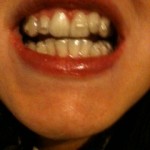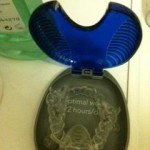Hi everyone, it’s Anna and I wanted to share with you how I’m doing on my third week of treatment. Some days I even forget they’re in there as they’re feeling really comfortable now. If you look at my picture you can ‘see’ just how invisible my aligners are! I love them!

I started on my second set of Invisalign trays on Tuesday, making sure to put them on the night before and take two paracetamol before I went to bed. This is a technique which the dental nurse at the Liverpool Dental Spa advised me to do as she herself has been through Invisalign treatment and told me that the initial first couple of days are the worst when it comes to putting on a new tray as they feel very tight.
All of the dental team have been very helpful and as some of them have undergone the same treatments which they offer to patients, it means they can provide recommendations based on personal experience.
Progress with the second set of trays
I’ve now had the second set of Invisalign trays on for around 3 days and I can say they are no longer feeling so tight, which again, can only be a good sign. The good news is that the second set – even in the initial first few days, were nowhere near as tight as the first set. They are easy to take on and off and wearing them for 22 hours a day no longer feels so daunting.
Admittedly, it can be hard to make sure to put it back on straight away after eating and I’m finding that I’m eating and drinking everything I want during this time, so I can avoid having to remove the aligners later on, only to have to brush my teeth.
This has meant that my snacking time has been greatly reduced, though I will admit on Valentine’s Day I did take them off for a bit longer than I was supposed to – (the chocolates were just too tempting!)
Drinking with aligners on
I also learnt last weekend not to drink anything but water with the aligners on. I went to the pub on Friday night and drank lemonade through a straw with my aligners in, which I thought would be ok, as I was reluctant to drink alcohol, in case of staining.
However after a few minutes I could feel the sugar from the lemonade under my aligners and my teeth just didn’t feel all that clean after that! I therefore think it might be safer to take them out if you’re planning on drinking on a night out. I know this can seem like a lot of wasted treatment time, but I think so long as you brush your teeth and put them back on before bed, you should be ok. However this might mean extending your treatment time of each tray by a day or two.
Overall, I’d say my progress has been good although it’s hard to tell if there’s been that much of a difference at this early stage. I will keep you posted by getting some pictures taken which can demonstrate the differences in my teeth (no matter how small).


